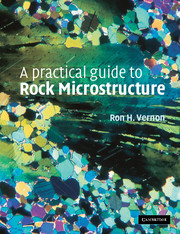Book contents
4 - Microstructures of metamorphic rocks
Summary
Introduction
Once you have seen what the microstructures of sedimentary and igneous rocks look like, you are in a good position to appreciate what happens to them when they are heated (Chapter 4) and deformed (Chapter 5) in Earth's crust. These processes can greatly alter the microstructure, producing no less beautiful, but very different grain and crystal shapes. Moreover, during heating, new minerals are produced.
This chapter is concerned with microstructures formed in the solid state, mainly as a result of metamorphism, but also discusses exsolution, which, though a solid-state process and so appropriate to this chapter in that sense, also occurs during the slow cooling of minerals in igneous rocks
The microstructure of a metamorphic rock is the end-product of a complex history that may involve sequences of complicated chemical reactions, and commonly also repeated deformation events. Although microscopic evidence is used to infer the metamorphic or deformation history, we should be careful not to try to extract too much information from it, and should remain aware of complexity and possible alternative interpretations.
Evidence for metamorphism
How do we know that rocks remain solid during metamorphism in Earth's crust? The evidence consists of residual sedimentary and igneous structures (Section 4.15), such as phenocrysts and amygdales (filled gas bubbles; Section 3.14.2) in metavolcanic rocks, fragmental grain shapes in metasandstones, distorted pebbles in metaconglomerates, and, less commonly, fossils replaced by metamorphic minerals.
- Type
- Chapter
- Information
- A Practical Guide to Rock Microstructure , pp. 169 - 294Publisher: Cambridge University PressPrint publication year: 2004

